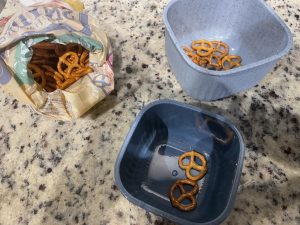82 The Cat That Ate And Ate But Never Gained Weight! – Instructor Guide
Natasha Ninkovic and Melissa Veliz
The Cat that Ate and Ate But Never Gained Weight!
Instructional Guide
The intention of the unit is to teach middle school students about hyperthyroidism and how it affects a cat’s gastrointestinal system.
Intended Grade Level
Middle school students grades 6-8. Students should have prior knowledge of the GI tract
Learning objectives
- Explain why a cat may eat a lot but still lose weight.
- Explain the importance of the thyroid.
- Describe the symptoms of hyperthyroidism.
Lesson Format
This can be done in any size group. Activities require at least two bowls and a bag of pretzels.
- First students will read through a chapter on hyperthyroidism in cats. This will be followed by a 2:44 minute video. (18 minutes)
- Next, students will play a game to demonstrate hyperthyroidism. Details are listed under the activities heading. (15 minutes)
- The assessment will be a short quiz focused on the learning objectives. (5 minutes)
Lesson Background
Cats have two thyroid glands in their neck these play important roles such as regulating metabolism. Hyperthyroidism is an endocrine disease that most commonly occurs in cats over 10 years of age. Enlargement of the thyroid gland causes an increase in production of the thyroid hormone. Increased production of the thyroid hormone increases the cat’s metabolic rate. A common symptom is weight loss as the animal is burning up calories faster than it can consume them. A good metaphor for this would be when your expenses outweigh your income. Other symptoms include a ravenous appetite, increased drinking, vomiting, and a poor hair coat.
Activities
Students will be divided into groups with 3 students in each group. There will be pretzels placed at the center of the table. One student tries to put as many pretzels as he/she can into a bowl while the other two students try to take pretzels away as fast as they can and place them into another bowl. They will have 5 minutes to complete this activity. The activity demonstrates that in cats with hyperthyroidism their body is using up more than what they can consume.

Common misconceptions and challenge points
It may be difficult for students to understand why an animal that is eating more is losing weight. The activity aims to to help students visualize the concept. Still, after the activity the instructor should explain how the activity relates to hyperthyroidism
Assessment
The assessment is a short, 5 multiple-choice question quiz based on the learning objectives, focused on asking students to review what they have learned throughout the lesson.
Further exploration
Other chapters within this textbook may be interesting for students. Some options can be found linked below:

